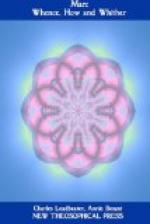The muscles are no longer arranged to form a sack as in annelids. Transverse muscles, running parallel to the unyielding plates of chitin or horn could accomplish nothing. They have largely disappeared. The work of locomotion has been transferred from the trunk to the legs.
The abdomen of the insect is as clearly composed of distinct segments as the body of the annelid. Of these there are perhaps typically eleven. The thorax is composed of three segments, distinct in the lowest forms, fused in the highest. This fusion of segments in the thorax of the highest forms furnishes a very firm framework for the attachment of wings and muscles. These wings are a new development, and how they arose is still a question. But they give the insect the capability of exceedingly rapid locomotion.
The three pairs of jaws, modified legs, in the rear half of the head show that this portion is composed of three segments. For only one pair of legs is ever developed on a single segment. Embryology has shown that the portion of the head in front of the mouth is also composed of three segments. Possibly between the prae- and post-oral portions still another segment should be included, making a total of seven in the head. The head has thus been formed by drawing forward segments from the trunk, and fusing them successively with the first or primitive head segment. This is difficult to conceive of in the fully developed insect, where the boundary between head and thorax is very sharp. But the ancestors of insects looked more like thousand-legs or centipedes, and here head and thorax are much less distinct. But in the annelid the mouth is on the second segment; here it is on the fourth. It has evidently travelled backward. That the mouth of an animal can migrate seems at first impossible, but if we had time to examine the embryology of annelids and insects, it would no longer appear inconceivable or improbable. And its backward migration brought it among the legs which were grasping and chewing the food. And in vertebrates the mouth has changed its position, though not in exactly the same way. Our present mouth is probably not at all the mouth of the primitive ancestor of vertebrates. Thus in the insect three segments have fused around the mouth, and three, possibly four, in front of it. This makes a head worthy of the name. The ganglia of the three post-oral segments, which bear the jaws, have fused in one compound ganglion innervating the mouth and jaws. Those of the three prae-oral segments have fused to form a brain. Eyes are well developed, giving images sometimes accurate in detail, sometimes very rude. Ears are not uncommon. The sense of smell is often keen.
Perhaps the greatest advance of the insect is its adaptation to land life. This gives it a larger supply of oxygen than any aquatic animal could ever obtain. This itself stimulates every function, and all the work of the body goes on more energetically. Then the heat produced is conducted off far less rapidly than in aquatic forms. Water is a good conductor of heat, and nearly all aquatic animals are cold-blooded. The few which are warm-blooded are protected by a thick layer of non-conducting fat. In all land animals, even when cold-blooded, the work of the different systems is aided by the longer retention of the heat in the body.




